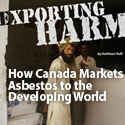Kathleen Ruff, RightOnCanada.ca
The number of cases of asbestos-related diseases in Quebec may reach its peak in the years 2008-2012 for men and 2008–2017 for women, according to a report published by the Quebec government’s National Public Health Institute (Tendances de l’incidence des mésothéliomes au Québec et au Canada de 1984 à 2007 et projections de 2008 à 2032).
The report shows that the rapid rise in asbestos mining between 1950 and 1977 was followed, in an exactly matching manner, by a rapid rise in cases of mesothelioma 35 years later, between the years 1984 and 2007 (the latest year for which data is available).
The number of cases of mesothelioma per 100,000 of the population was higher in Quebec than in the rest of Canada, with Quebec women having double the rate of mesothelioma of women in the rest of Canada between 1984 and 2007.
These higher levels can be explained by the higher level of asbestos mining in Quebec, says the report. In the 1960s, ten of the thirteen asbestos mines in Canada were located in Quebec, with the other three being in British Columbia, the Yukon and Newfoundland-Labrador. Over the years, three quarters of Canada’s asbestos production came from Quebec.
Failure to achieve “safe use” of asbestos in Quebec
Another factor causing the higher levels of mesothelioma in Quebec could be significant exposure levels in factories making asbestos containing products, notes the report. A study of twenty-three asbestos processing factories in Montreal at the end of the 1990s showed that 30% of the factories failed to comply with occupational exposure regulations. Another study, ten years later in 2008, identified only nine factories using asbestos. In none of the nine factories were proper safety standards being followed.
In a follow-up survey in 2102, the Quebec National Public Health Institute (INSPQ) identified six Quebec factories still using chrysotile asbestos. In its publication, Projet Amiante-Industries 2012 : bilan, the INSPQ reported that two of the factories used asbestos from a Quebec mine, two used asbestos-containing materials provided respectively by an Ontario supplier and a supplier in the Czech Republic. The source of the asbestos for the other two factories was not known.
One of the six factories was planning to change to non asbestos-containing materials in a few months. In the other five factories, tests showed that of 13 workers, one worker was exposed to over 1 fibre of asbestos per cubic centimetre of air (1 f/cc), five workers were exposed to between 0.1 and 1 f/cc and seven workers were exposed to below 0.1 f/cc.
Occupational health and safety regulations set by Europe, the US and provinces across Canada, with the exception of Quebec, require that no worker be exposed to higher than 0.1 f/cc of asbestos. The Quebec Occupational Health & Safety Commission (CSST) has set a priority policy of zero tolerance for worker exposure to asbestos fibres. The provincial regulations in Quebec, adopted at a time when the Quebec asbestos mining industry controlled the Quebec and Canadian governments’ policies on asbestos, still, however, permit exposure of 1 f/cc – ten times higher than the rest of Canada, the US and Europe.
The INSPQ has asked the Quebec government to adopt stricter regulations, pointing out that there is no safe exposure level to chrysotile asbestos and that studies have shown that in factories and in the construction industry in Quebec, asbestos is not being handled safely.
The 2012 INSPQ study of factories handling asbestos thus showed that almost half of the workers were exposed to levels of asbestos fibres that violate occupational health and safety regulations in the rest of Canada, in Europe and in the US and that clearly violate the Quebec CSST policy of “zero tolerance” for worker exposure to asbestos.
The INSPQ stated that, according to the information it had obtained, manufacture or handling of asbestos-containing products in Quebec is decreasing or about to stop in four of the factories it identified. The reasons given were the difficulty of obtaining asbestos fibres (due to the closing of the Quebec asbestos mines), the decreasing demand for this type of product and the substitution of other fibres in the place of asbestos.
The INSPQ study shows once again that even in an economically and technically advanced society like Quebec, which benefits from a regime of occupational safety regulations and government inspectors, workers were nevertheless exposed to hazardous levels of asbestos fibres.
Even though the asbestos mines are now closed in Quebec, it will take another 20 years before diseases caused by asbestos drop to the 1984 level, said the INSPQ report. It warned, however, that its prediction of a slow decline in asbestos-related diseases is dependent on the population being exposed less and less to asbestos.
Key recommendations for action on asbestos
In a further report, the INSPQ reviewed the recommendations it made from 2003 to 2009 regarding health risks posed by asbestos. It assessed the degree to which its recommendations have been implemented and put forward additional recommendations (Recommandations à la suite des connaissances acquises sur l’exposition à l’amiante et sur les maladies des travailleurs et de la population générale du Québec de 2003 à 2009).
The INSPQ stressed the following as three key recommendations:
- That Quebec’s occupational safety regulations should be strengthened and, in particular, the permitted exposure level to asbestos should made more stringent.
- That the Quebec government should pass a law that would require building owners to identify places in which asbestos-containing materials are present.
- That the Quebec government should implement a program to monitor levels of asbestos concentrations in the asbestos mining towns of Quebec.
Additionally, the INSPQ recommended that the Quebec Ministry of Health and Social Services monitor the status of a proactive approach to the safe management of asbestos in schools, education centres, health and municipal public buildings.
Shame on the Canadian government
While scientists working for the Quebec government’s leading health institute speak up and make recommendations to their government to take action on the asbestos issue, scientists working for the Canadian government are gagged and silenced.
Not a single Canadian government scientist has ever dared speak up to challenge the Canadian government’s appallingly irresponsible pro-asbestos policy, which has been repeatedly condemned by medical experts across Canada and around the world. Health experts working for Health Canada are forced to acquiesce in a policy, written by the asbestos industry, that continues to be the government’s policy today and that they know causes harm to health and loss of life.
Shame on Prime Minister Stephen Harper and his government for suppressing scientific evidence, for gagging government scientists and for letting industry lobby groups write Canada’s environmental and health policies.



December 16th, 2013 at 1:14 am
Governments continuing to allow use of this killer material should charged with wilful crimes against humanity.